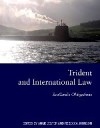by Cynthia Cockburn
There is a long tradition of women organizing against the Bomb. On the 1 March 1954 the United States tested a nuclear weapon on Bikini Atoll in the Pacific Ocean. Japanese fishermen in their boat The Lucky Dragon, were caught in the radioactive fallout. The incident caused a wave of anti-nuclear activism in Japan beginning in Suginami, Tokyo. And it was mainly the women of Suginami who organized a petition to ban nuclear weapons that raised just short of 30 million signatures in two months. French and US atmospheric nuclear tests also sparked off another response, at the opposite end of the Pacific Ocean, an important part of which was ‘Women for a Nuclear Free and Independent Pacific’. One reason women organized was because so many of the children to which they gave birth after they were irradiated by the nuclear tests had terrible birth defects.
Later, in the 1980s, there was a huge movement of women in the UK against the introduction here of US Cruise nuclear missiles that centered on the RAF base at Greenham Common, where a substantial arsenal of nuclear missiles was to be stationed. A group of women set out from Cardiff in Wales and walked a hundred miles to Greenham. When they arrived, on 5 September 1981, four of them chained themselves to the fence demanding a televised debate with the Secretary of State for Defence. This was the start of a spontaneous women’s peace camp that soon had more than a hundred women living under plastic and canvas, and thousands more coming at weekends from support groups that sprang up around the country. On 12 December 1982 an estimated 30,000 women completely ‘embraced the base’ around its 14 kilometre fence. The camp persisted till after the last missile had been returned to the USA in 1991. Women who camped at Greenham went on to contribute hugely to anti-nuclear work elsewhere, setting up camps at the missile-warning station at Menwith Hill, at the nuclear weapons research and manufacturing facilities at Aldermaston and Burghfield, organising the Nukewatch Network, and continuing world-wide links with other women protesting against nuclear weapons in their countries. Women still form the backbone of the anti-nuclear movement today.
What is it that brings women out as women against nuclear weapons, or against war, or against militarism itself? For twelve years now I have been researching feminist antiwar organizing. In the course of fact-finding in a score of countries I have found that women usually have three reasons for organizing separately as women. The first is that women have an experience of militarism and war that is specific to their gender. Birthing babies with terrible birth defects DUE TO RADIATION is just one of these experiences. Rape of women on an epidemic scale, as in the Bosnian war and in the Congo and Sudan now – that is another. Then again, women often feel special anger about military expenditure because it reduces the budget available for the public and social services on which so many women, who do the majority of domestic, health and care work, paid and unpaid, specially depend. Women organize as women to make women’s particular experience in peace and war visible and understood.
The second reason behind ‘women-only’ antiwar activism is simply for effectiveness, for women to be able to exercise choice. Often in mixed groups it is men who take a lead. They may not mean to dominate, but somehow their voices carry more weight. It is not the case in all groups. There are some in the peace movement that are very careful in the way they conduct gender relations. But some women in the not-so-wonderful groups sometimes get to think, they have told me, ‘I can’t waste my time with this “double militancy” - having to struggle in the group in order to struggle out there in the world. Let’s do it on our own.’ That going “WOMEN ONLY” makes women’s voices more audible, and women can make choices, choose styles and strategies of organization and action, that feel comfortable to them as women, and are different from those of some mixed groups.
So – first, getting women’s experience visible; second, doing things in a particular way. But there is a third reason some women choose to organize as women, and it may be more significant than the other two. It is because there is a feminist analysis of militarism and war that is lacking in the thinking of the mainstream movement. Militarism and war are products of systems of power. The main two war-sustaining systems are (1) capitalism – the class power of money and property; and (2) nationalism – the racist power of the state, white rule, ethnic hatred. Both are systems of oppression and exploitation and are thus essentially, necessarily, violent. The antiwar movement mobilizes against both those systems of power. Feminists say, ‘Hold on…there’s another system of power intertwined with those two. It too is oppressive, exploitative and violent. It too predisposes society to militarism and war. It’s called patriarchy”. What feminists mean by patriarchy is the millennia-old, world-wide, almost universal form of gender order in which men exercise power over women, and which fosters a kind of masculinity that thrives on domination and force.
So, some women say, the antiwar movement needs to address, yes, capitalist exploitation, and, yes, racist, nationalist impulses, but also systemic male power. All three, nothing less. Struggle for a transformation of gender relations has to be recognized as peace work. In our very own antiwar, antimilitarist and peace movements, just as we try not to behave like little capitalists, and just as we do not tolerate racism, so we should not tolerate sexism. Our activism has to reflect the world we want to create. Totally. Prefigurative struggle, it’s called.
I want to end by stressing that we are not talking here about men and women as such, let alone about individual men and women. We are talking about cultures - cultures that thrive and multiply everywhere from bank boardrooms, to the pub on a Saturday night, from TV commercials to computer games, cultures that set up masculinity and femininity as caricatures of human ‘being’, that create a whole symbolic system in which particular qualities are ascribed to masculinity, and given supremacy. What is a ‘real man’? Being authoritative, combative, defended, controlling, hard, always ready to use violence to defend honour. It is clear that these qualities are deeply implicated in militarism and war. And women make a connection here: actual men either find the courage to refuse this model or they act it out. And when they act it out, they do so not only in the military, but also in everyday life, in ways that are very costly to women. So women can hardly avoid seeing violence as a continuum, one that stretches from the school playground, bedroom and back street to the battlefield, from their own bodies to the body politic. It may be that our movement is something more than an antiwar movement, more even than a peace movement. It may be a movement for a nonviolent world.
To come back to nuclear weapons…One day in the summer of 2005, two women went to Stockholm to address a meeting of the prestigious Weapons of Mass Destruction Commission chaired by Hans Blix. He had invited them to speak on ‘the relevance of gender for eliminating weapons of mass destruction’. They received a careful hearing. And they spoke about how ideas about gender – what is deemed masculine or feminine, powerful or impotent, affect our efforts towards halting the proliferation of WMD. They drew on detailed research that revealed the laddish, boys’-own, culture of a certain nuclear policy institute. Research that had analysed and revealed how the fear of being seen as ‘soft’ or ‘wimpish’ had influenced actual political decisions to go to war in recent times. They also cited research that shows the tight link between masculine identity, men’s sense of self, and the ownership of a gun (or a knife or a pit-bull terrier). The man-gun affinity is something that has been found in many countries to hinder demobilization after war. The two women told the Commissioners:
‘There’s now general recognition that there are significant gender dimensions to the possession of small arms and light weapons. It would be naïve to assume that this association suddenly becomes meaningless when we’re talking about larger, more massively destructive weapons. And it’s more naïve still to think it doesn’t matter.’
So, do not be surprised to find women taking an active part in the anti-nuclear movement, often with banners and placards with messages that might have been written by women in countries as far apart as Colombia and Spain, India and the Philippines, saying things like: ‘Spend money on services not nuclear weapons’, ‘Security for women? Disarm masculinity. Disarm militaries’, and ‘No fists, no knives, no guns, no bombs - no to all violence’.
References
Cockburn, Cynthia (2007) ‘From Where We Stand: War, Women’s Activism and Feminist Analysis.’ London and New York: Zed Books.
Cohn, Carol with Felicity Hill and Sara Ruddick (2005) ‘The relevance of gender for eliminating weapons of mass destruction’. Adaptation of a presentation to the Commission on 12 June 2005. Paper No.38. Stockholm: Commission on Weapons of Mass Destruction.
Website www.womeninblack.org

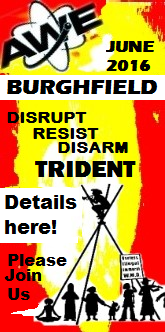
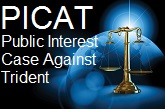
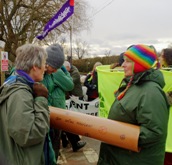







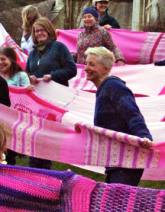
 Nuclear weapons crime in the UK has been reported to Thames Valley Police.
Nuclear weapons crime in the UK has been reported to Thames Valley Police.









